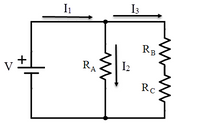
a) Write an equation for the currents entering in/out of the top junction in Figure 1. Use I1 as the current coming from the left, I2 as the current going downward, and I3 as the current going to the right.
b) You will need to draw two loops in order to solve this circuit. Write the corresponding voltage equations for these loops in terms of V, VA, VB, and VC; where VA, VB and VC are voltages across the resistors RA, RB and RC respectively.
c) Using Ohm's law combined with the equations you found above; express I1, I2, and I3 as equations in terms of the known quantities V, RA, RB, and RC.
d) Now you have all the information you need to express VA, VB and VC as equations in terms of V, RA, RB and RC.

Trending nowThis is a popular solution!
Step by stepSolved in 2 steps with 2 images

- A capacitor has a peak current of 330 μA when the peak voltage at 330 kHz is 2.8 V. Part A What is the capacitance? Express your answer to two significant figures and include the appropriate units. C = Submit Part B Ic= μA Value Submit Request Answer If the peak voltage is held constant, what is the peak current at 660 kHz ? Express your answer to two significant figures and include the appropriate units. μA Value Units Request Answer biệt Units wwwwwarrow_forwardQ.1arrow_forwardA.) Determine Reg for the combination of resistors shown below. R, = 600 N, R2 = 500 N, & R3 = 800 2. R1 R2 Reg R3arrow_forward
- a) Find the equivalent resistance of the illustrated circuit. b) Using Ohm's law, determine the current and potential difference in each of the resistors. At the end, make a table with all the results. c) Determine the power dissipated by the 12 Ω resistor.arrow_forwardAn electric circuit consisting of wires, batteries and resistors is shown. All currents have been labeled and assigned directions. a.) Which statement is a correct expression of Kirchhoff's Junction Rule for currents with labels and directions assigned on the above figure? I1 + I2 + I3 = 0 I1 - I2 + I3 = 0 None of these statements are correct. I1 - I2 - I3 = 0 I1 + I2 - I3 = 0 b.) Which statement is a correct expression of Kirchhoff's Loop Rule for the sum of voltage changes for the large outer loop? 18.0 V - (80.0 Ω)I1 + 12.0 V + (50.0 Ω)I3 + (80.0 Ω)I3 = 0 18.0 V - (80.0 Ω)I1 - 12.0 V + (50.0 Ω)I3 + (80.0 Ω)I3 = 0 None of these statements are correct. 18.0 V - (80.0 Ω)I1 + 12.0 V - (50.0 Ω)I3 - (80.0 Ω)I3 = 0 -18.0 V - (80.0 Ω)I1 - 12.0 V + (50.0 Ω)I3 + (80.0 Ω)I3 = 0 18.0 V - (80.0 Ω)I1 - 12.0 V - (50.0 Ω)I3 - (80.0 Ω)I3 = 0arrow_forward
 College PhysicsPhysicsISBN:9781305952300Author:Raymond A. Serway, Chris VuillePublisher:Cengage Learning
College PhysicsPhysicsISBN:9781305952300Author:Raymond A. Serway, Chris VuillePublisher:Cengage Learning University Physics (14th Edition)PhysicsISBN:9780133969290Author:Hugh D. Young, Roger A. FreedmanPublisher:PEARSON
University Physics (14th Edition)PhysicsISBN:9780133969290Author:Hugh D. Young, Roger A. FreedmanPublisher:PEARSON Introduction To Quantum MechanicsPhysicsISBN:9781107189638Author:Griffiths, David J., Schroeter, Darrell F.Publisher:Cambridge University Press
Introduction To Quantum MechanicsPhysicsISBN:9781107189638Author:Griffiths, David J., Schroeter, Darrell F.Publisher:Cambridge University Press Physics for Scientists and EngineersPhysicsISBN:9781337553278Author:Raymond A. Serway, John W. JewettPublisher:Cengage Learning
Physics for Scientists and EngineersPhysicsISBN:9781337553278Author:Raymond A. Serway, John W. JewettPublisher:Cengage Learning Lecture- Tutorials for Introductory AstronomyPhysicsISBN:9780321820464Author:Edward E. Prather, Tim P. Slater, Jeff P. Adams, Gina BrissendenPublisher:Addison-Wesley
Lecture- Tutorials for Introductory AstronomyPhysicsISBN:9780321820464Author:Edward E. Prather, Tim P. Slater, Jeff P. Adams, Gina BrissendenPublisher:Addison-Wesley College Physics: A Strategic Approach (4th Editio...PhysicsISBN:9780134609034Author:Randall D. Knight (Professor Emeritus), Brian Jones, Stuart FieldPublisher:PEARSON
College Physics: A Strategic Approach (4th Editio...PhysicsISBN:9780134609034Author:Randall D. Knight (Professor Emeritus), Brian Jones, Stuart FieldPublisher:PEARSON





